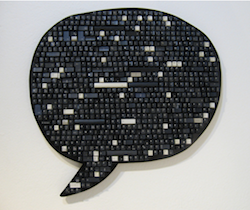 New tools are at their most powerful, Clay Shirky says, once they’re ubiquitous enough to become invisible. Twitter may be increasingly pervasive — a Pew study released yesterday shows that 13 percent of online adults use the service, which is up from 8 percent six months ago — but it’s pretty much the opposite of invisible. We talk to each other on Twitter, yes, but almost as much, it seems, we talk to each other about it.
New tools are at their most powerful, Clay Shirky says, once they’re ubiquitous enough to become invisible. Twitter may be increasingly pervasive — a Pew study released yesterday shows that 13 percent of online adults use the service, which is up from 8 percent six months ago — but it’s pretty much the opposite of invisible. We talk to each other on Twitter, yes, but almost as much, it seems, we talk to each other about it.
Often, we yell. The big debates about Twitter’s overall efficacy as a medium — like the one launched by, say, Bill Keller, whose resignation from The New York Times’ editorship some Twitterers have attributed (jokingly? I think?) to his Twitter-take-on columns — tend to conclude without much consensus. A recent (and comparatively calm) debate between Mathew Ingram and Jeff Jarvis ended like so: “I guess we will have to agree to disagree.”
But why all the third-railiness? Twitter, like many other subjects of political pique, tends to be framed in extremes: On the one hand, there’s Twitter, the cheeky, geeky little platform — the perky Twitter bird! the collective of “tweets”! all the twee new words that have emerged with the advent of the tw-efix! — and on the other, there’s Twitter, the disruptor: the real-time reporting tool. The pseudo-enabler of democratic revolution. The existential threat to the narrative primacy of the news article. Twetcetera.
The dissonance here could be chalked up to the fact that Twitter is simply a medium like any other medium, and, in that, will make of itself (conversation-enabler, LOLCat passer-onner, rebellion-facilitator) whatever we, its users, make of it. But that doesn’t fully account for Twitter’s capacity to inspire so much angst (“Is Twitter making us ____?”), or, for that matter, to inspire so much joy. The McLuhany mindset toward Twitter — the assumption of a medium that is not only the message to, but the molder of, its users — seems to be rooted in a notion of what Twitter should be as much as what it is.
Which begs the question: What is Twitter, actually? (No, seriously!) And what type of communication is it, finally? If we’re wondering why heated debates about Twitter’s effect on information/politics/us tend to be at once so ubiquitous and so generally unsatisfying…the answer may be that, collectively, we have yet to come to consensus on a much more basic question: Is Twitter writing, or is it speech?
The broader answer, sure, is that it shouldn’t matter. Twitter is…Twitter. It is what it is, and that should be enough. As a culture, though, we tend to insist on categorizing our communication, drawing thick lines between words that are spoken and words that are written. So libel is, legally, a different offense than slander; the written word, we assume, carries the heft of both deliberation and proliferation and therefore a moral weight that the spoken word does not. Text, we figure, is: conclusive, in that its words are the deliberate products of discourse; inclusive, in that it is available equally to anyone who happens to read it; exclusive, in that it filters those words selectively; archival, in that it preserves information for posterity; and static, in that, once published, its words are final.
And speech, while we’re at it, is discursive and ephemeral and, importantly, continual. A conversation will end, yes, but it is not the ending that defines it.
Those characteristics give way to categories. Writing is X; speaking is Y; and both have different normative dimensions that are based on, ultimately, the dynamics of power versus peer — the talking to versus the talking with. So when we talk about Twitter, we tend to base our assessments on its performance as a tool of either orality or textuality. Bill Keller seems to see Twitter as text that happens also to be conversation, and, in that, finds the form understandably lacking. His detractors, on the other hand, seem to see Twitter as conversation that happens also to be text, and, in that, find it understandably awesome.
 Which would all be fine — nuanced, even! — were it not for the fact that Twitter-as-text and Twitter-as-conversation tend to be indicated by the same word: “Twitter.” In the manner of “blogger” and “journalist” and even “journalism” itself, “Twitter” has become emblematic of a certain psychology — or, more specifically, of several different psychologies packed awkwardly into a single signifier. And to the extent that it’s become a loaded word, “Twitter” has also become a problematic one: #Twittermakesyoustupid is unfair, but #”Twitter”makesyoustupid has a point. The framework of text and speech falls apart once we recognize that Twitter is both and neither at once. It’s its own thing, a new category.
Which would all be fine — nuanced, even! — were it not for the fact that Twitter-as-text and Twitter-as-conversation tend to be indicated by the same word: “Twitter.” In the manner of “blogger” and “journalist” and even “journalism” itself, “Twitter” has become emblematic of a certain psychology — or, more specifically, of several different psychologies packed awkwardly into a single signifier. And to the extent that it’s become a loaded word, “Twitter” has also become a problematic one: #Twittermakesyoustupid is unfair, but #”Twitter”makesyoustupid has a point. The framework of text and speech falls apart once we recognize that Twitter is both and neither at once. It’s its own thing, a new category.
Our language, however, doesn’t yet recognize that. Our rhetoric hasn’t yet caught up to our reality — for Twitter and, by extension, for other social media.
And whether we deem Twitter a text-based mechanism of orality, as the scholar Zeynep Tufekci has suggested, or of a “secondary orality,” as Walter Ong has argued, or of something else entirely (tweech? twext? something even more grating, if that’s possible?), it almost doesn’t matter. The point is to acknowledge, online, a new environment — indeed, a new culture — in which writing and speech, textuality and orality, collapse into each other. Speaking is no longer fully ephemeral. And text is no longer simply a repository of thought, composed by an author and bestowed upon the world in an ecstasy of self-containment. On the web, writing is newly dynamic. It talks. It twists. It has people on the other end of it. You read it, sure, but it reads you back.
In his social media-themed session at last year’s ONA conference, former Lab writer and current Wall Street Journal outreach editor Zach Seward talked about being, essentially, the voice of the outlet’s news feed on Twitter. When readers tweeted responses to news stories, @WSJ might respond in kind — possibly surprising them and probably delighting them and maybe, just for a second, sort of freaking them out.
The Journal’s readers were confronted, in other words, with text’s increasingly implicit mutuality. And their “whoa, it’s human!” experience — the Soylent Greenification of online news consumption — can bring, along with its obvious benefits, the same kind of momentary unease that accompanies the de-commodification of, basically, anything: the man behind the curtain, the ghost in the machine, etc. Concerns expressed about Twitter, from that perspective, may well be stand-ins for concerns about privacy and clickstream tracking and algorithmic recommendation and all the other bugs and features of the newly reciprocal reading experience. As the filmmaker Tze Chun noted to The New York Times this weekend, discussing the increasingly personalized workings of the web: “You are used to looking at the Internet voyeuristically. It’s weird to have the Internet looking back at you….”
So a Panoptic reading experience is also, it’s worth remembering, a revolutionary reading experience. Online, words themselves, once silent and still, are suddenly springing to life. And that can be, in every sense, a shock to the system. (Awesome! And also: Aaaah!) Text, after all, as an artifact and a construct, has generally been a noun rather than a verb, defined by its solidity, by its thingness — and, in that, by its passive willingness to be the object of interpretation by active human minds. Entire schools of literary criticism have been devoted to that assumption.
And in written words’ temporal capacity as both repositories and relics, in their power to colonize our collective past in the service of our collective future, they have suggested, ultimately, order. “The printed page,” Neil Postman had it, “revealed the world, line by line, page by page, to be a serious, coherent place, capable of management by reason, and of improvement by logical and relevant criticism.” In their architecture of sequentialism, neatly packaged in manuscripts of varying forms, written words have been bridges, solid and tangible, that have linked the past to the future. As such, they have carried an assurance of cultural continuity.
It’s that preservative function that, for the moment, Twitter is largely lacking. As a platform, it does a great job of connecting; it does, however, a significantly less-great job of conserving. It’s getting better every day; in the meantime, though, as a vessel of cultural memory, it carries legitimately entropic implications.
But, then, concerns about Twitter’s ephemerality are also generally based on a notion of Twitter-as-text. In that, they assume a zero-sum relationship between the writing published on Twitter and the writing published elsewhere. They see the written, printed word — the bridge, the badge of a kind of informational immortality — dissolving into the digital. They see back-end edits revising stories (which is to say, histories) in an instant. They see hacks erasing those stories altogether. They see links dying off at an alarming rate. They see all that is solid melting into bits.
And they have, in that perspective, a point: While new curatorial tools, Storify and its ilk, will become increasingly effective, they might not be able to recapture print’s assurance, tenacious if tenuous, of a neatly captured world. That’s partly because print’s promise of epistemic completeness has always been, to some extent, empty; but it’s also because those tools will be operating within a digital world that is increasingly — and actually kind of wonderfully — dynamic and discursive.
What the concerns about Twitter tend to forget, though, is that language is not, and has never been, solid. Expression allows itself room to expand. Twitter is emblematic, if not predictive, of the Gutenberg Parenthesis: the notion that, under the web’s influence, our text-ordered world is resolving back into something more traditionally oral — more conversational and, yes, more ephemeral. “Chaos is our lot,” Clay Shirky notes; “the best we can do is identify the various forces at work shaping various possible futures.” One of those forces — and, indeed, one of those futures — is the hybrid linguistic form that we are shaping online even as it shapes us. The digital sphere calls for a new paradigm of communication: one that is discursive as well as conservative, one that acquiesces to chaos even as it resists it, one that relies on text even as it sheds the mantle of textuality. A paradigm we might call “Twitter.”
Photos by olalindberg and Tony Hall used under a Creative Commons license.